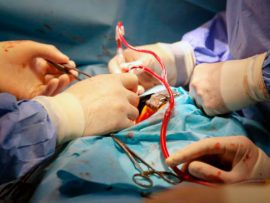Abstract Objective To explore the factors affecting patient outcomes in pulmonary artery thromboendarterectomy (PTE) under deep hypothermic circulatory arrest (DHCA) and cardiopulmonary bypass (CPB) support and to provide a reference..
Read MoreAbstract Background Aortic aneurysms involving the proximal aortic arch, which require hemiarch-type repair, typically require circulatory arrest with antegrade cerebral perfusion. Left carotid antegrade cerebral perfusion (LCP) via distal arch..
Read MoreAbstract Diseases affecting the aortic arch often require surgical intervention. Hypothermic circulatory arrest (HCA) enables a safe approach during open aortic arch surgeries. Additionally, HCA provides neuroprotection by reducing cerebral..
Read MoreAbstract Background Cerebral protection strategies during proximal remains controversial due to lack of evidence and large patient . We herein evaluated our 3-decade experience using hypothermic circulatory arrest with retrograde (DHCA/RCP) to evaluate..
Read MoreAbstract Introduction We hypothesized that perioperative fibrinogen level, platelet count, and rotational thromboelastometry (ROTEM) data values decrease in proportion to cardiopulmonary bypass (CPB) time, particularly in patients who underwent deep..
Read MoreAbstract Acute kidney injury (AKI) is a common cause of morbidity after congenital heart disease surgery. Progress on diagnosis and therapy remains limited, however, in part due to poor mechanistic..
Read MoreAbstract Background Oxylipins are metabolites derived from fatty acids such as arachidonic acid (AA) and are key mediators in inflammation, host defense, and tissue injury. Serum oxylipins increase in adults..
Read MoreAbstract Objective: To investigate the influences of deep hypothermic circulatory arrest (DHCA) on postoperative cranial nerve function in patients undergoing surgery for type A aortic dissection. Methods: A total of 100 patients..
Read MoreAbstract Background: Acute type A aortic dissection (ATAAD) has a high risk of perioperative bleeding and often requires extensive blood product infusions. Analysis of the changes in coagulation and fibrinolysis..
Read MoreAbstract The use of total circulatory arrest (TCA)/deep hypothermic circulatory arrest (DHCA) as a support modality in congenital heart surgery is a time-tested strategy. However, with technological advances, the widespread..
Read More





